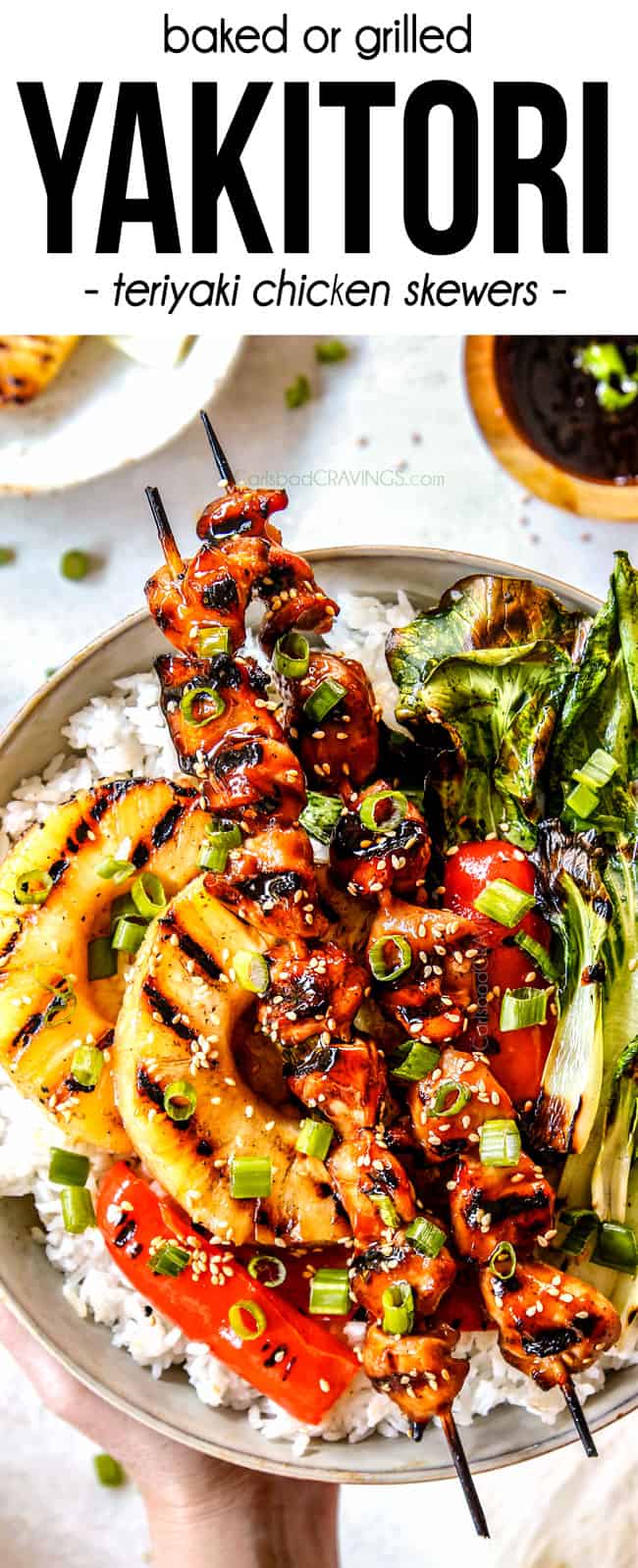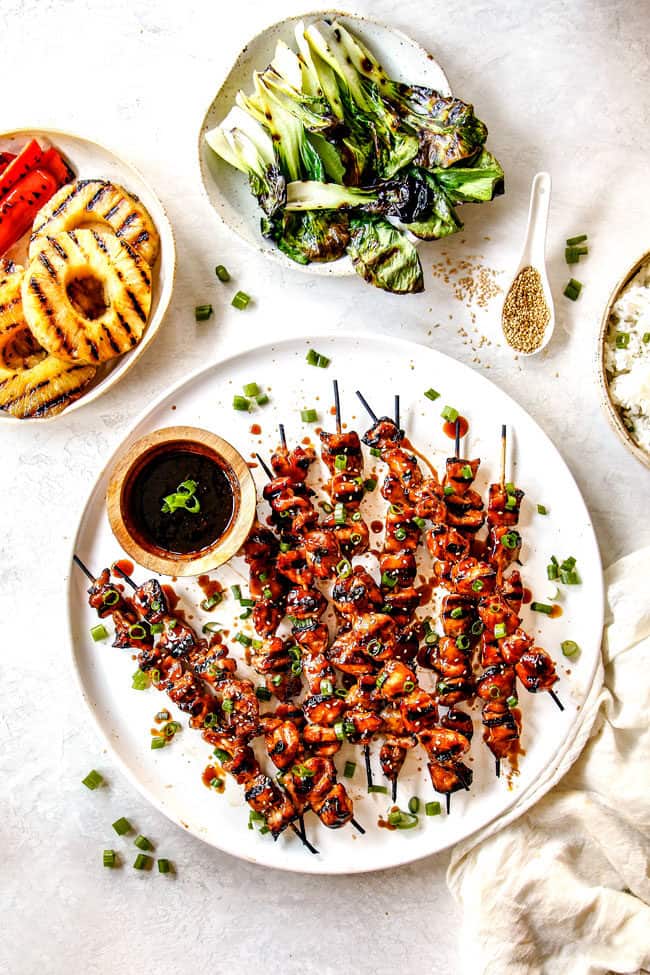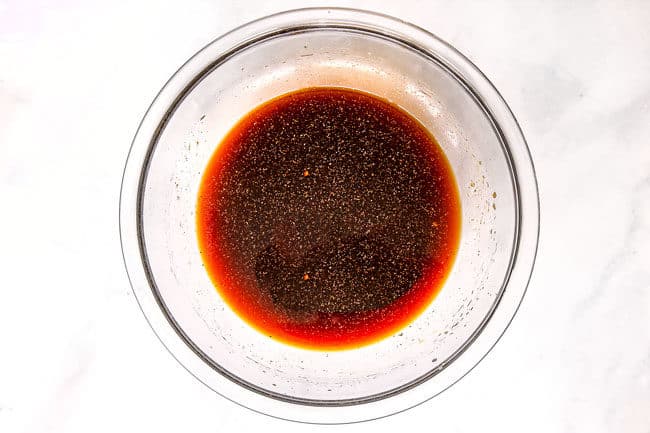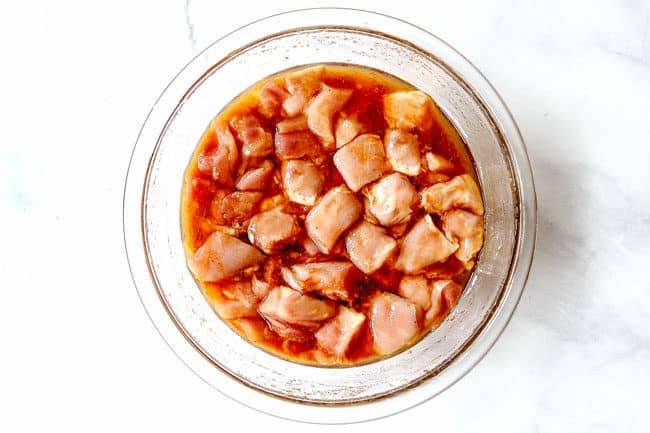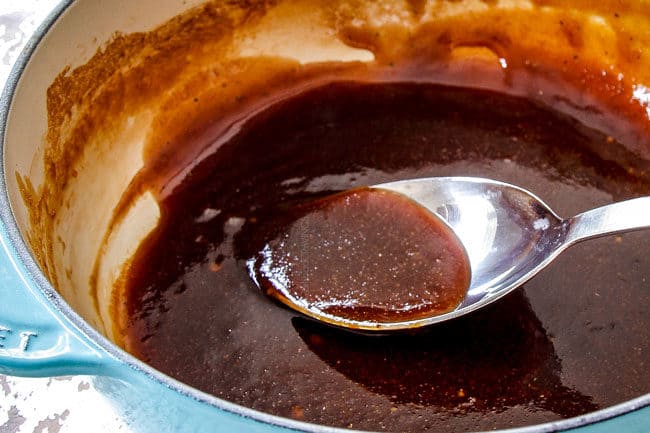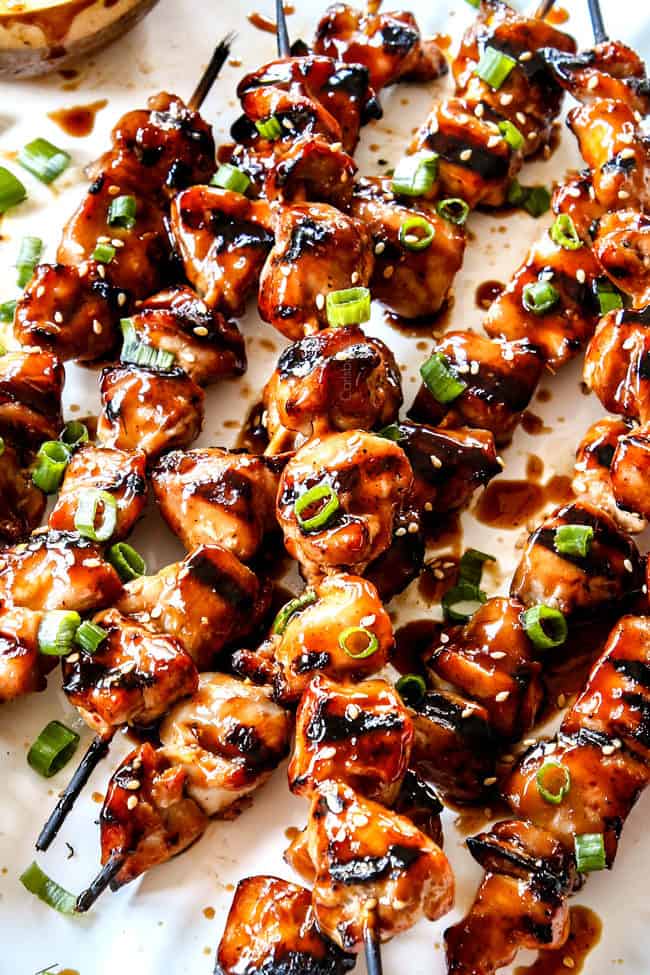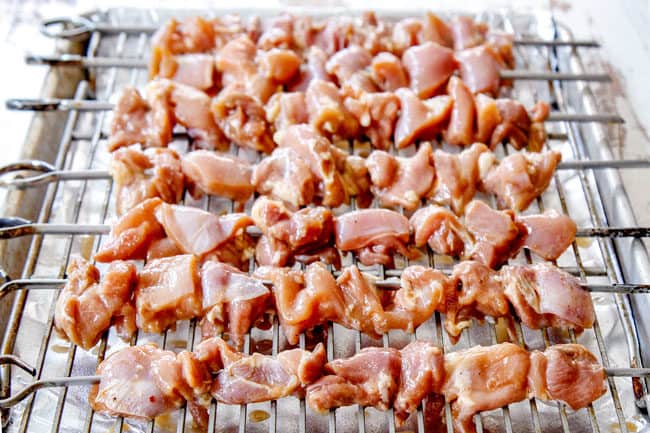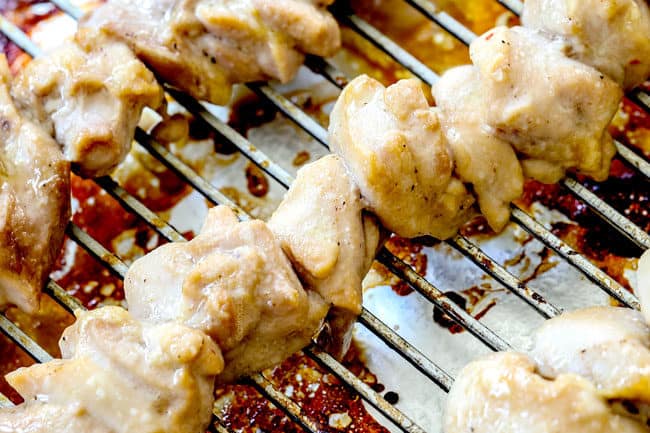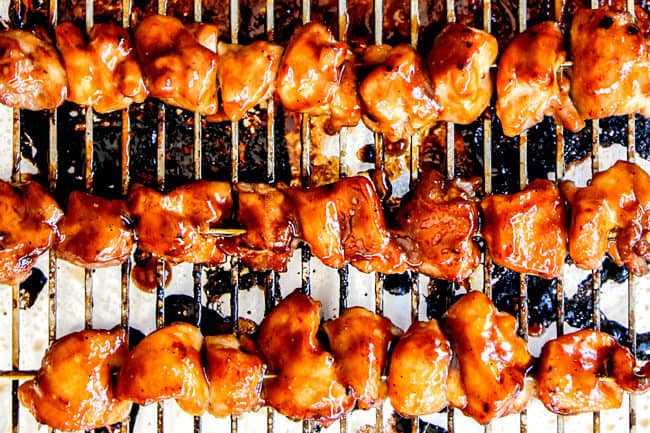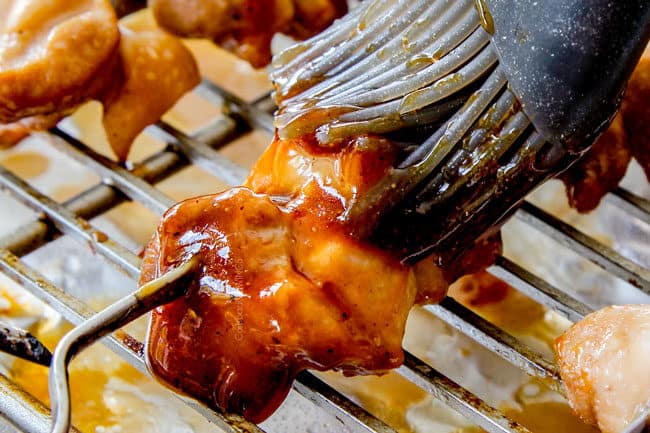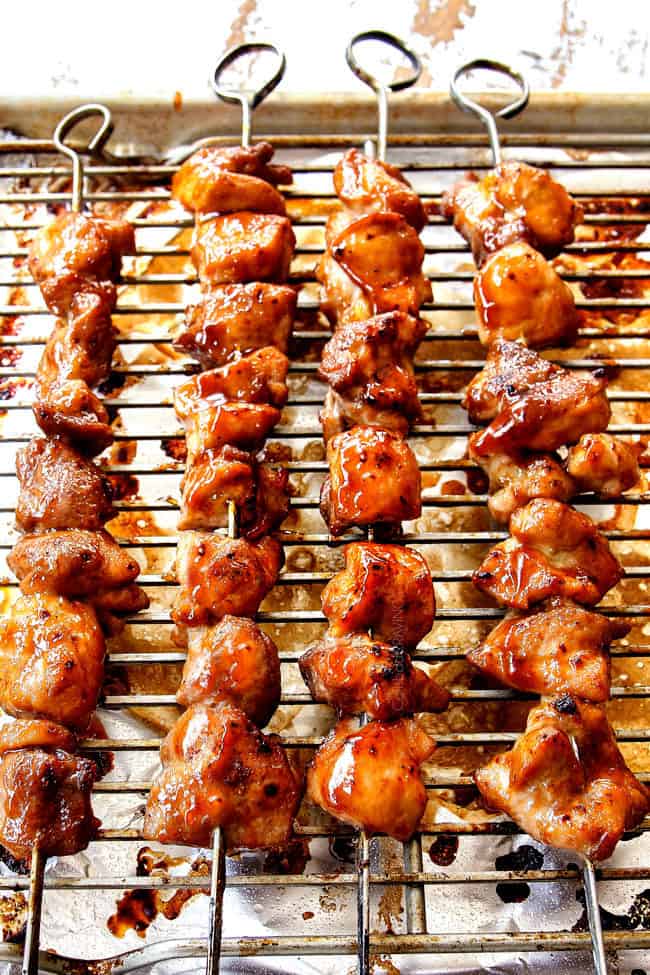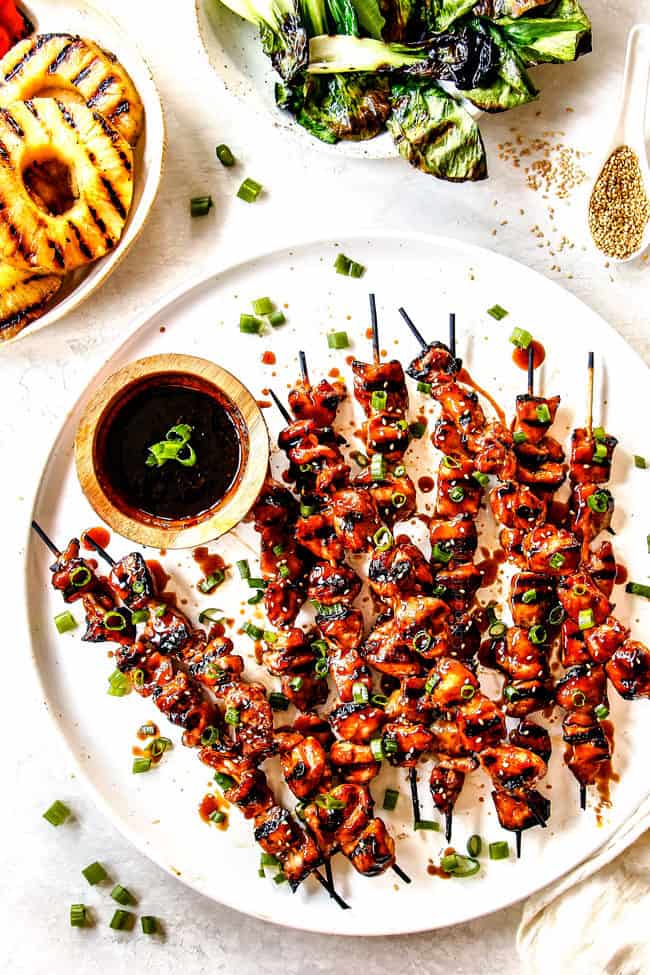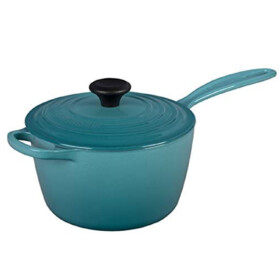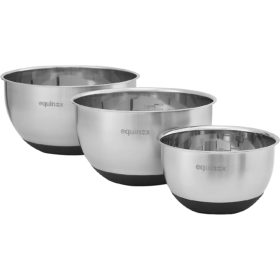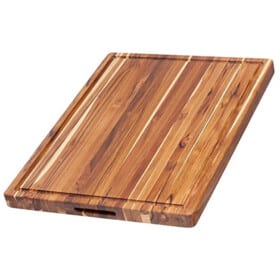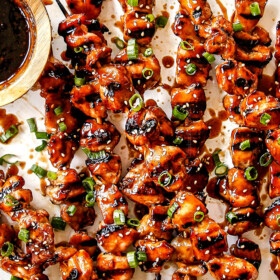PIN THIS RECIPE TO SAVE FOR LATER
Chicken Yakitori
I’m thrilled to introduce you to this yakitori recipe just in time for the 4th of July. But truth be told, with the oven and grilling option, I hop this becomes a year round favorite. Oh, how I love the yakitori, let me count the ways…
Easy. Yakitori is easy to make with a marinade that doubles as the tare sauce – just whisk a few ingredients together and done and done! Simple ingredients. Yakitori uses pantry staples so you can make it any time. I’ve even included a swap for Japanese rice wine if you don’t keep it stocked. Economical. Yakitori is typically made from economical chicken thighs. FLAVOR! This isn’t just straight teriyaki sauce, but complex, multi-faceted tare sauce elevated by ginger, garlic and Asian Sweet Chili. Make ahead. You can marinate and skewer the yakitori in advance then just grill when ready. Versatile. You can cook yakitori on the grill or in the oven – instructions included for both! JUICY and so TENDER. The use of chicken things AND the marinade results in crazy juicy, tender, flavorful chicken. Ultimate appetizer. These elegant skewers make fantastic finger food that are easily manageable by guests. Ultimate dinner: While chicken yakitori is traditionally an appetizer, we like to serve it for dinner, because we like to till up just on this chicken delight. And as a dinner recipe, you can make it ALL the time. Crowd pleaser. Whenever I serve these chicken skewers, everyone gobbles them up and asks for the recipe! Customizable. You can use any part of the chicken and even add vegetables such as traditional scallions or leeks or anything else: zucchini, mushrooms, tomatoes, asparagus, pineapple, etc. Special Diet friendly: Yakitori is low carb, paleo, and can be made gluten free.
What is Yakitori?
You have probably heard of yakitori (焼き鳥) but what exactly is it? Here’s a simple breakdown of yakitori to better understand the epitome of Japanese barbecue OR you can skip directly to details about the recipe or use “the jump to recipe” button at the top of the page to skip to the recipe.
What does Yakitori mean? In Japanese yakitori literally means grilled chicken: yaki translates to “grill” and tori means “chicken.” What part of the chicken is yakitori? True to its name, yakitori refers to bite-size grilled chicken skewers (sometimes vegetables) made from all parts of the chicken such as thighs, breasts, wings, neck, liver, skin, cartilage, hearts, etc. For this yakitori recipe we are using chicken thighs which is called momo yakitori (もも). How is yakitori cooked? The chicken is skewered on bamboo sticks and cooked to order. The skewers are grilled over a special type of Japanese grill using binchōtan, a white charcoal that burns at extremely high temperature- over 1800F/1000C! The grill itself is a rectangular clay box designed for the skewers to lay across the opening so the chicken can dangle over the open flame while the ends of the bamboo stay protected on the edge of the box so they don’t burn. Of course, our homemade chicken yakitori can be made in the oven or grill – no binchōtan, required! What sauce for yakitori? Chicken yakitori is either served with salt (shio) or with sweet and savory yakitori sauce known as tare like we are serving in this recipe. Tare is much like a thick, sweetened teriyaki sauce. The chicken yakitori is coated in tare twice: once while grilling and second after the chicken is fully cooked to create a caramelized, irresistible flavor bomb. Where is Yakitori Served? While this yakitori recipe will likely be consumed around your dinner table or backyard patio, it is traditionally a very popular appetizer served along with beer at Yakitori bars, restaurants known yakitori-ya, izakaya restaurants (Japanese tapas) and other bar-type restaurants in Japan.
What is yakitori sauce made of?
Yakitori sauce, known as tare, is made of similar ingredients to teriyaki sauce – so don’t let the exotic vocabulary scare you. Tare is traditionally made of soy sauce, mirin (a sweet cooking sake), sake, and sugar with the option of ginger and/or garlic. For this yakitori sauce recipe, I’ve gone all sort of non-traditional by replacing some of the sugar with Asian Sweet Chili Sauce (like I do in my teriyaki chicken recipe with spectacular results) and replacing the sake with pantry friendly apple cider vinegar and sugar. By substituting some of the sugar with Asian Sweet Chili Sauce, we not only get sweet but we get sweet heat infused with red chilies, garlic and ginger – a depth of flavor that can’t be beat. I also added additional garlic and ginger for more layers of complex flavors that will have you licking your plate – no flat yakitori sauce here! And the good news, all of the ingredients are pantry staples if you do much Asian cooking and can customize the yakitori sauce to just your taste – add more sugar for sweeter, add more soy sauce for saltier, add more vinegar for more tang or more ginger for more of a kick. The resulting tare sauce is sweet, salty, silky and absolutely sensational.
YAKITORI INGREDIENTS
WHAT CHICKEN IS BEST FOR YakitorI Recipe?
Momo yakitori is made with boneless, skinless chicken thighs AKA the key to the juiciest chicken skewers. Chicken thighs are dark meat and so much juicier and more flavorful than chicken breasts. Their additional fat keeps the chicken moist and tender as they cook and makes them more forgiving than chicken breasts so they are harder to dry out. So, for the BEST yakitori – I urge you to go with chicken thighs! Pro Tip: if you’re looking at package of chicken thighs and it doesn’t say “boneless or bone-in,” know that boneless chicken thighs are always skinless. So, if you’re holding a package of thighs with skin – they are always bone-in.
Can I use chicken breasts?
Of course! A few notes for grilling chicken breasts:
Chicken breasts are leaner so take care to marinate them for a sufficient amount of time so they can still merge juicy. Don’t overcook chicken breasts or they will dry out. Pound chicken breasts to an even thickness so they cook evenly. I suggest using chicken fillets, which are large chicken breasts sliced through the equator to create 4 thinner cuts. This yakitori recipe calls for 2” pieces of chicken – this is so you can fold the thighs over on themselves and then skewer-if using chicken breasts, use 1 1/2” pieces instead.
What Skewers are Best?
HOW TO MAKE YAKITORI
This Chicken Yakitori recipe comes together super quickly because the chicken marinade and the tare sauce are made with the SAME ingredients you whisk together once! As in, all your prep is literally done in minutes! Here’s how:
Prep chicken. Trim chicken of extra gristle. I find it’s easiest to use kitchen shears to snip it right off. Chop the thin part to of the chicken thighs into 2” piece so you can fold it over and the thicker parts into 1 1/2” pieces so they’ll be roughly the same size as the thin pieces once folded. Whisk yakitori sauce ingredients together. To make this easy tare sauce, whisk together the soy sauce, sugar, Japanese rice wine, Asian sweet chili sauce, apple cider vinegar, garlic, ginger and cornstarch in a small bowl.
Use part of the sauce to create marinade. Remove ⅓ cup of the yakitori sauce and add it to a large bowl or freezer bag along with 3 tablespoons olive oil to create the marinade. Add chicken and give it a good stir. Marinate Chicken. Marinate chicken for 30 minutes at room temperature or covered in the refrigerator. Refrigerate remaining sauce separately.
Skewer chicken. Thread chicken onto skewers, folding the thin pieces over so they get skewered through twice. Thicken sauce. Add reserved yakitori sauce (not marinade) to a saucepan and simmer until thickened to the consistency of barbecue sauce, about 3 minutes.
HOW TO GRILL YAKITORI
Grease grill. I use a wad of paper towels with oil to generally grease the grill. You don’t want to use cooking spray. Start hot. Heat grill to high heat. This will sear the chicken and cause the complex Maillard reaction for maximum flavor. Add chicken. Once hot, add chicken, reduce heat to medium (350 degrees F with lid on), cover and grill chicken 3-4 minutes per side, or until chicken is cooked through (internal temp of 165 degrees F). Baste chicken. Baste chicken with some of the tare sauce the last minute of cooking on each side. At this point, the chicken will be opaque and cooked on the outside so you don’t need to worry about cross-contamination. Final baste. Once chicken is cooked, brush once more all over with sauce.
HOW TO BAKE YAKITORI
I have tried both grilling and baking/broiling this chicken yakitori and absolutely loved both! We are going to broil the chicken to mimic the direct heat of grilling. It might look like quite a few steps, but the entire process takes less than 15 minutes: 10-ish minutes cooking and the other 5 prep/basting.
TO BAKE YAKITORI:
Heat oven. Turn oven to broil so it can get hot before adding chicken. Position oven racks. Place one oven rack in the middle of the oven and a second rack about 10” away from the broiler. Prepare baking sheet. Line a baking sheet with foil (for easy cleanup) and top with a baking rack. Lightly spray rack with nonstick cooking spray.
1st broil on middle rack. Line chicken skewers on baking rack so they aren’t touching. Place chicken in the oven on the MIDDLE rack and broil for 6 minutes.
Baste and broil on top rack. Remove chicken from oven and baste the top of the skewers with sauce. Return to oven on the TOP rack and broil for approximately 2 minutes or until starting to char. Watch closely so the chicken doesn’t burn. This will help caramelize the yakitori sauce.
Flip, baste and broil bottom side. Remove chicken from oven, flip over, and baste the other side with sauce. Return to oven on the TOP rack and broil for approximately 2 minutes or until starting to char. Watch closely so the chicken doesn’t burn.
Check chicken for doneness. Insert a meat thermometer into the thickest part of a thick piece of chicken or cut the thickest piece open. If chicken isn’t quite done, then return to the middle rack and broil until done (I haven’t had to do this). Baste again. Brush cooked chicken with sauce and EAT!
Tips and TRICKS FOR Yakitori
Use reduced sodium soy sauce! If you don’t use reduced sodium soy sauce then your yakitori will be too salty. Don’t cut chicken too small. Chicken thighs aren’t straight forward cubes like chicken breasts but don’t stress too much about it. I recommend cutting thinner part of the chicken into 2” pieces and then folding it back on itself as you skewer to create a thicker piece. I then chop the thicker pieces into 1 ½” pieces so all of the chicken is roughly the same size so they cook evenly. Avoid cutting the chicken too small or it can easily overcook. Marinate longer! For maximum flavor and tenderness, I recommend that you marinate the chicken for 12 hours. The longer you marinate it for, the more flavorful it will become. Space chicken close together. I like to pack the chicken pieces pretty close together – so they are touching but not smashed together. If you pack them too tight, the middle may not cook through but if you place them just touching, then this helps prevent overcooking and promotes juicier chicken. Many hands make light work: The yakitori skewers can be assembled in minutes if you enlist some helping hands. Don’t mix chicken. Don’t combine chicken thighs and chicken breasts on one skewer because they can require different cooking times. Space skewers apart. Make sure there is room in between the chicken skewers when you grill or broil so your chicken cooks and doesn’t just steam. Don’t overcook chicken. The most important aspect of cooking chicken with any method is not to overcook it – no one wants dry chicken! I recommend investing in an instant-read thermometer so you know exactly when your chicken is done so you can pull it off the heat immediately.
Yakitori Sauce Tips
HOW DO I THICKEN Yakitori SAUCE?
The cornstarch in the yakitori sauce will thicken the sauce as it simmers. Make sure to constantly whisk as the yakitori sauce simmers and thicken so it doesn’t burn and so the starch can separate and expand. If you still would like a thicker sauce, then just keep simmering until it reaches desired consistency.
HOW DO I THIN Yakitori SAUCE?
Your yakitori sauce can thicken as it cools. If you need to thin it, simply whisk in additional water. If it is not easily mixing, then whisk over low heat.
HOW DO I STORE Yakitori SAUCE?
If you have leftover yakitori sauce, you can store it in an airtight container in the refrigerator for up to 5 days.
IS Yakitori SAUCE GLUTEN FREE?
Yakitori Sauce is not gluten free as written due to the soy sauce. You can easily make it gluten free by substituting gluten free soy sauce such as tamari. Also, double check your Asian Sweet Chili Sauce to ensure it is gluten free.
recipe variations
While this Yakitori recipe is just right for us, you can adjust it to make it just right for YOU and your family’s personal tastes.
Sweeten it up: with additional sugar or swap the sugar for honey. Add sweet heat: with additional Asian sweet chili sauce. Spice it up: add additional Asian chili sauce to taste. Add herbs such as Thai basil, coriander or cilantro. Amp up the garlic and/or ginger: for a stronger punch of flavor. Make kabobs: Thread the Yakitori with pineapple, bell peppers, onions, mushrooms, etc.
How to Store Chicken Yakitori?
Leftover chicken yakitori should be stored in an airtight container in the refrigerator. When properly stored, it is good for up to 5 days.
HOW TO REHEAT YAKITORI?
CAN I FREEZE YAKITORI?
Absolutely! The rule of thumb is that you can freeze meat/chicken once when raw, and once when cooked.
I love the idea of freezing a big batch of uncooked skewers because then you always have an easy dinner on hand. Simply pull the yakitori out and grill straight from frozen! OR you can freeze the chicken in the marinade. When ready to use, let it defrost in the refrigerator and continue with the recipe as outlined.
To freeze:
Place assembled skewers on a baking sheet in a single layer so thy aren’t touching. Freeze for 1-2 hours until solid. This flash freezing ensures they freeze quickly and evenly and prevents them from sticking together if transferred to a container. Once frozen, you can either wrap the whole baking sheet in heavy-duty foil or transfer the frozen skewers to a Ziploc freezer bag and squeeze out excess air. If the skewers are too long, then wrap the stacked yakitori a few times in plastic wrap then in foil. When ready to cook, grill kabobs from frozen, covered, over medium-high heat, turning frequently, for a total of about 15 minutes. You can also bake them from frozen on a lightly greased baking rack over a baking sheet at 400 degrees F for approximately 15 minutes.
WHAT SIDES DO I SERVE WITH chicken yakitori?
My favorite side to serve with yakitori is steamed rice. The chicken is so flavorful, that the rice offers a neutral, textural counterpart. Here are some more delicious side dish options:
Rice: White rice, brown rice, quinoa, cauliflower rice, broccoli rice or Pineapple Rice. Veggies. You can make veggie kabobs to grill alongside your yakitori or stir fry any veggies your heart desires from broccoli, to bell peppers, to mushrooms, to carrots, etc. You can also serve with roasted veggies such as Roasted Broccoli, Roasted Broccolini, Roasted Cauliflower, Roasted Carrots, Sautéed Brussels Sprouts, or Roasted Squash. Shortcut Veggies. You an can purchase pre-chopped veggies perfect for stir fries or use a frozen stir-fry blend or steam-in-the-bag microwavable frozen veggies. Salad. You can serve yakitori with Crunchy Asian Salad, Chinese Salad, Asian Pineapple Salad or add the chicken directly to these salads. Soups: Miso Soup, Thai Noodle Soup, Curried Butternut Squash Soup, Thai Soup Fruit: Grilled Pineapple, Summer Fruit Salad, Perfect Fruit Salad, Creamy Grape Salad, Pina Colada Fruit Salad Appetizers. For an Asian feast, yakitori is delicious with Wontons, Asian Salad, Potstickers, Wonton Soup and Chinese Chicken Egg Rolls.
Ways to serve Yakitori Leftovers
Yakitori Chicken and Rice Bowls: top jasmine or cauliflower rice with yakitori, stir fried vegetables, and chopped up pineapple. Yakitori Tacos: Add yakitori to flour tortillas and top with pineapple salsa, pineapple mango salsa or grilled pineapple mango salsa like my teriyaki chicken tacos. Yakitori Quesadillas: Add to quesadillas along with Monterrey Jack cheese and pineapple. Yakitori Pizza: top store-bought pizza dough, homemade pizza dough, flatbread or sliced French bread with tomato sauce spiked with Asian chili sauce, ginger, garlic and soy sauce, followed by shredded mozzarella cheese, yakitori and other toppings of choice such as snap peas, thinly sliced red onions, pineapple, water chestnuts, etc. Bake until the cheese is melted and bubbly.
Want to try this YAKITORI RECIPE?
Pin it to your CHICKEN or DINNER Board to SAVE for later!
Find me on Pinterest for more great recipes! I am always pinning :)!
©Carlsbad Cravings by CarlsbadCravings.com Carlsbad Cravings© Original Tag @CarlsbadCravings and Use #CarlsbadCravngs Leave a Review, I Always Love Hearing From You!
